Legal Analysis: IRAC Method for Workplace Law Cases
VerifiedAdded on 2021/05/30
|14
|2610
|95
Report
AI Summary
This report provides an analysis of four court decisions related to workplace law, employing the IRAC (Issue, Rule, Application, Conclusion) method. The cases examined include *Fair Work Ombudsman v Quest South Perth Holdings Pty Ltd*, *Fair Work Ombudsman v Happy Cabby Ltd & Anor*, *Fair Work Ombudsman v Centennial Financial Services Pty Ltd & Ors*, and *Stevens v Brodribb Sawmilling Company Proprietary Limited*. The report deconstructs each case by identifying the key legal issues, outlining the relevant rules of law applied by the courts, detailing how the courts applied these rules to the specific facts of the case, and summarizing the final conclusions or holdings. The analysis focuses on matters such as sham contracting, the distinction between employees and independent contractors, and the application of the Fair Work Act 2009. The report aims to provide a structured understanding of the cases by applying the IRAC method to the facts and legal principles involved.
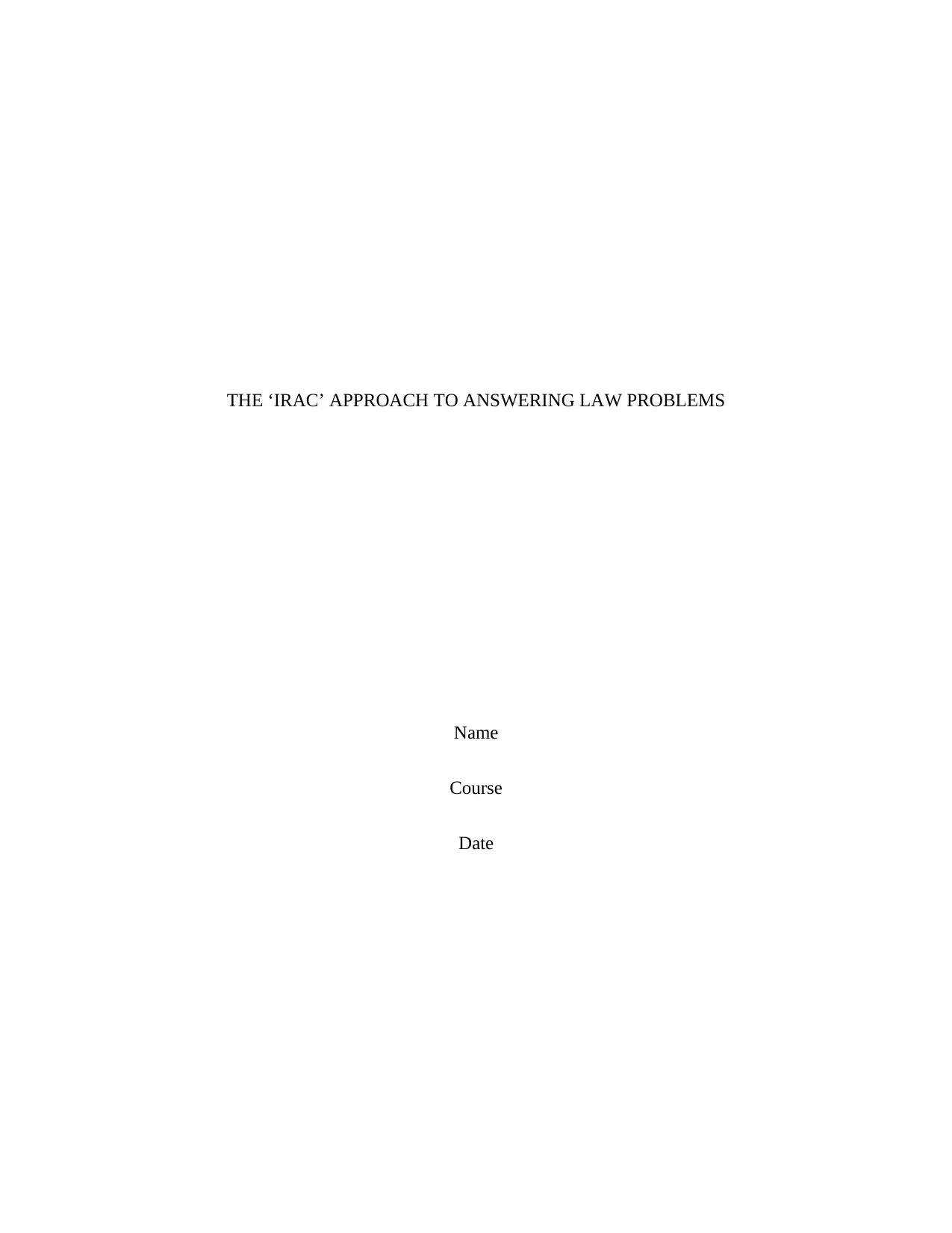
THE ‘IRAC’ APPROACH TO ANSWERING LAW PROBLEMS
Name
Course
Date
Name
Course
Date
Paraphrase This Document
Need a fresh take? Get an instant paraphrase of this document with our AI Paraphraser
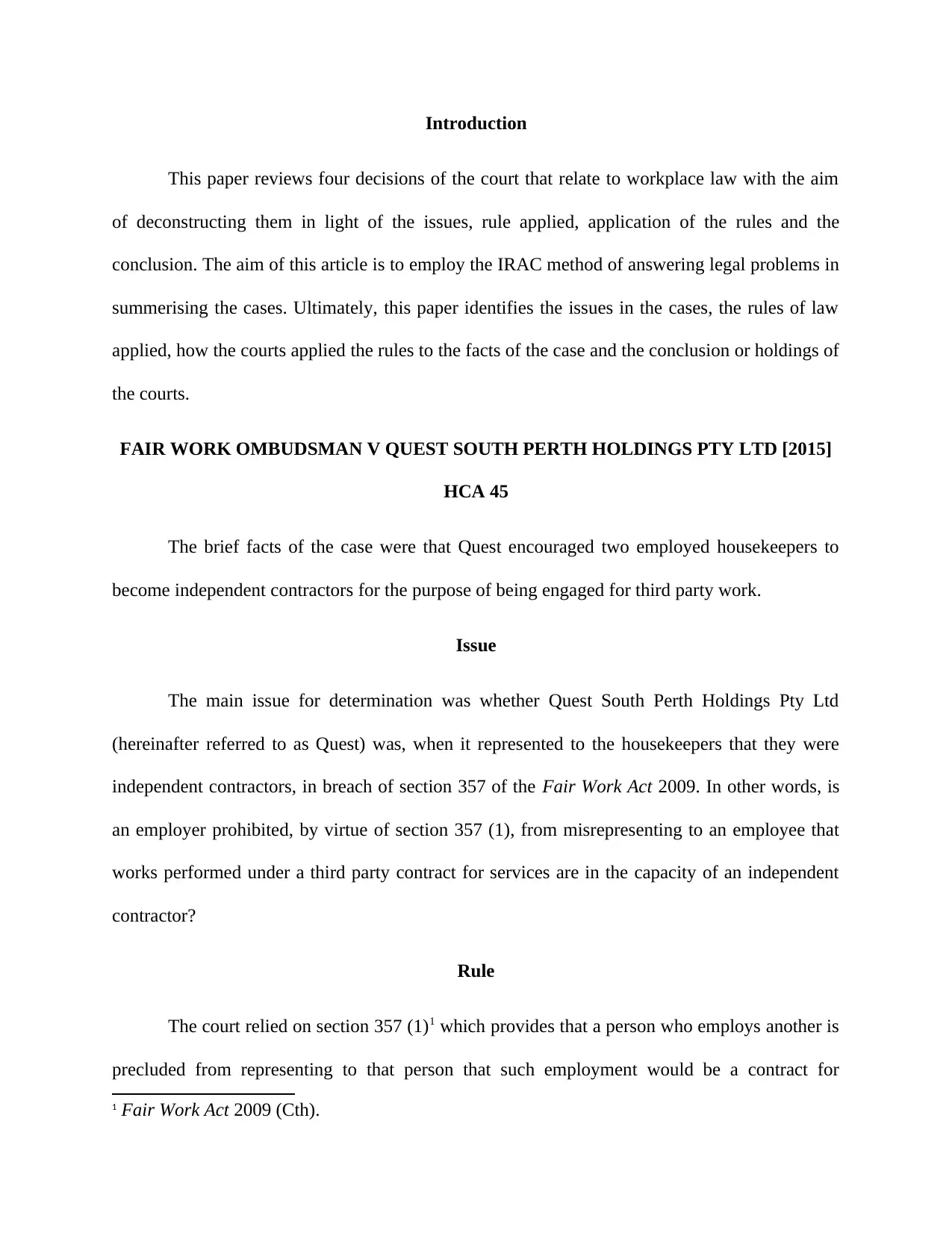
Introduction
This paper reviews four decisions of the court that relate to workplace law with the aim
of deconstructing them in light of the issues, rule applied, application of the rules and the
conclusion. The aim of this article is to employ the IRAC method of answering legal problems in
summerising the cases. Ultimately, this paper identifies the issues in the cases, the rules of law
applied, how the courts applied the rules to the facts of the case and the conclusion or holdings of
the courts.
FAIR WORK OMBUDSMAN V QUEST SOUTH PERTH HOLDINGS PTY LTD [2015]
HCA 45
The brief facts of the case were that Quest encouraged two employed housekeepers to
become independent contractors for the purpose of being engaged for third party work.
Issue
The main issue for determination was whether Quest South Perth Holdings Pty Ltd
(hereinafter referred to as Quest) was, when it represented to the housekeepers that they were
independent contractors, in breach of section 357 of the Fair Work Act 2009. In other words, is
an employer prohibited, by virtue of section 357 (1), from misrepresenting to an employee that
works performed under a third party contract for services are in the capacity of an independent
contractor?
Rule
The court relied on section 357 (1)1 which provides that a person who employs another is
precluded from representing to that person that such employment would be a contract for
1 Fair Work Act 2009 (Cth).
This paper reviews four decisions of the court that relate to workplace law with the aim
of deconstructing them in light of the issues, rule applied, application of the rules and the
conclusion. The aim of this article is to employ the IRAC method of answering legal problems in
summerising the cases. Ultimately, this paper identifies the issues in the cases, the rules of law
applied, how the courts applied the rules to the facts of the case and the conclusion or holdings of
the courts.
FAIR WORK OMBUDSMAN V QUEST SOUTH PERTH HOLDINGS PTY LTD [2015]
HCA 45
The brief facts of the case were that Quest encouraged two employed housekeepers to
become independent contractors for the purpose of being engaged for third party work.
Issue
The main issue for determination was whether Quest South Perth Holdings Pty Ltd
(hereinafter referred to as Quest) was, when it represented to the housekeepers that they were
independent contractors, in breach of section 357 of the Fair Work Act 2009. In other words, is
an employer prohibited, by virtue of section 357 (1), from misrepresenting to an employee that
works performed under a third party contract for services are in the capacity of an independent
contractor?
Rule
The court relied on section 357 (1)1 which provides that a person who employs another is
precluded from representing to that person that such employment would be a contract for
1 Fair Work Act 2009 (Cth).
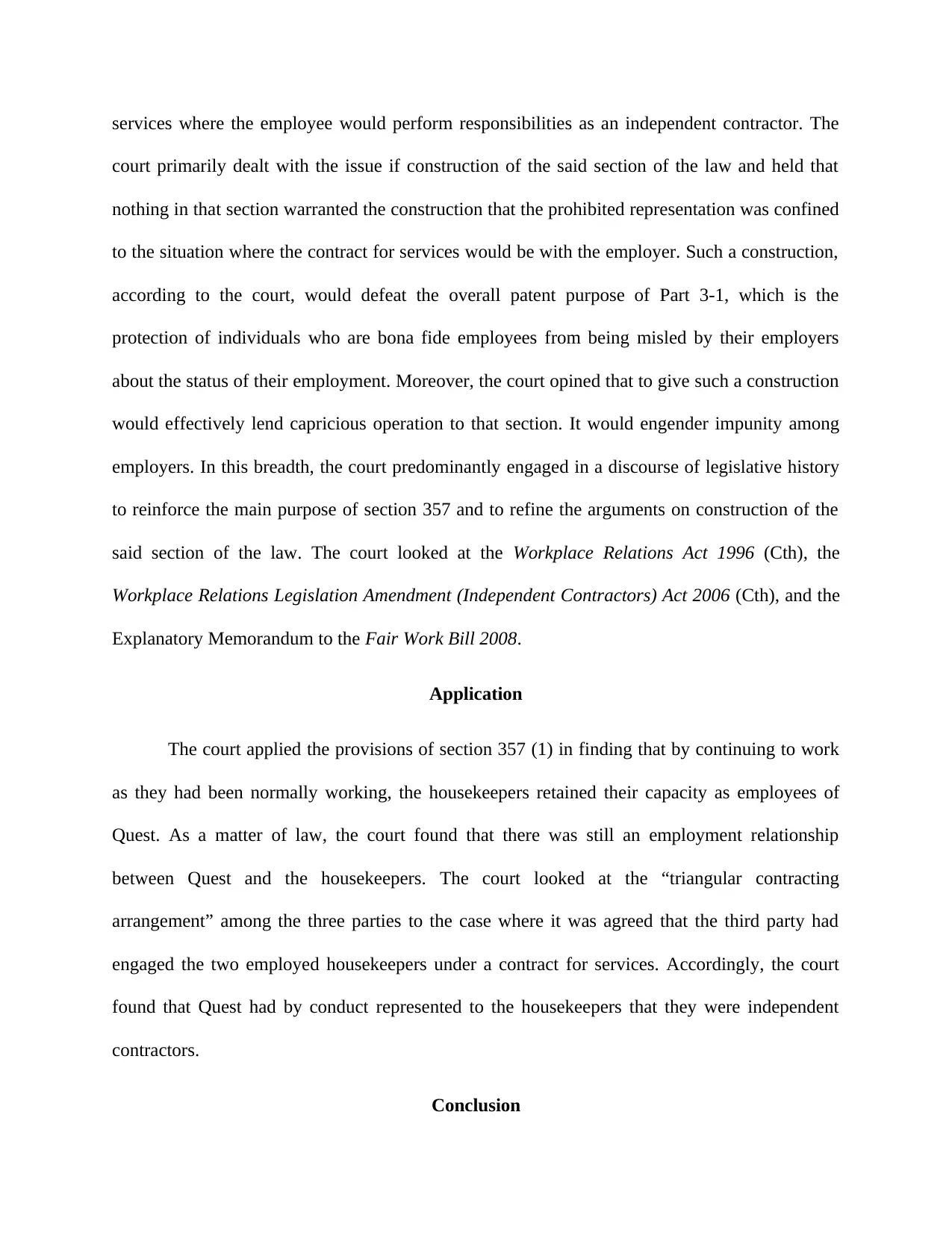
services where the employee would perform responsibilities as an independent contractor. The
court primarily dealt with the issue if construction of the said section of the law and held that
nothing in that section warranted the construction that the prohibited representation was confined
to the situation where the contract for services would be with the employer. Such a construction,
according to the court, would defeat the overall patent purpose of Part 3-1, which is the
protection of individuals who are bona fide employees from being misled by their employers
about the status of their employment. Moreover, the court opined that to give such a construction
would effectively lend capricious operation to that section. It would engender impunity among
employers. In this breadth, the court predominantly engaged in a discourse of legislative history
to reinforce the main purpose of section 357 and to refine the arguments on construction of the
said section of the law. The court looked at the Workplace Relations Act 1996 (Cth), the
Workplace Relations Legislation Amendment (Independent Contractors) Act 2006 (Cth), and the
Explanatory Memorandum to the Fair Work Bill 2008.
Application
The court applied the provisions of section 357 (1) in finding that by continuing to work
as they had been normally working, the housekeepers retained their capacity as employees of
Quest. As a matter of law, the court found that there was still an employment relationship
between Quest and the housekeepers. The court looked at the “triangular contracting
arrangement” among the three parties to the case where it was agreed that the third party had
engaged the two employed housekeepers under a contract for services. Accordingly, the court
found that Quest had by conduct represented to the housekeepers that they were independent
contractors.
Conclusion
court primarily dealt with the issue if construction of the said section of the law and held that
nothing in that section warranted the construction that the prohibited representation was confined
to the situation where the contract for services would be with the employer. Such a construction,
according to the court, would defeat the overall patent purpose of Part 3-1, which is the
protection of individuals who are bona fide employees from being misled by their employers
about the status of their employment. Moreover, the court opined that to give such a construction
would effectively lend capricious operation to that section. It would engender impunity among
employers. In this breadth, the court predominantly engaged in a discourse of legislative history
to reinforce the main purpose of section 357 and to refine the arguments on construction of the
said section of the law. The court looked at the Workplace Relations Act 1996 (Cth), the
Workplace Relations Legislation Amendment (Independent Contractors) Act 2006 (Cth), and the
Explanatory Memorandum to the Fair Work Bill 2008.
Application
The court applied the provisions of section 357 (1) in finding that by continuing to work
as they had been normally working, the housekeepers retained their capacity as employees of
Quest. As a matter of law, the court found that there was still an employment relationship
between Quest and the housekeepers. The court looked at the “triangular contracting
arrangement” among the three parties to the case where it was agreed that the third party had
engaged the two employed housekeepers under a contract for services. Accordingly, the court
found that Quest had by conduct represented to the housekeepers that they were independent
contractors.
Conclusion
⊘ This is a preview!⊘
Do you want full access?
Subscribe today to unlock all pages.

Trusted by 1+ million students worldwide
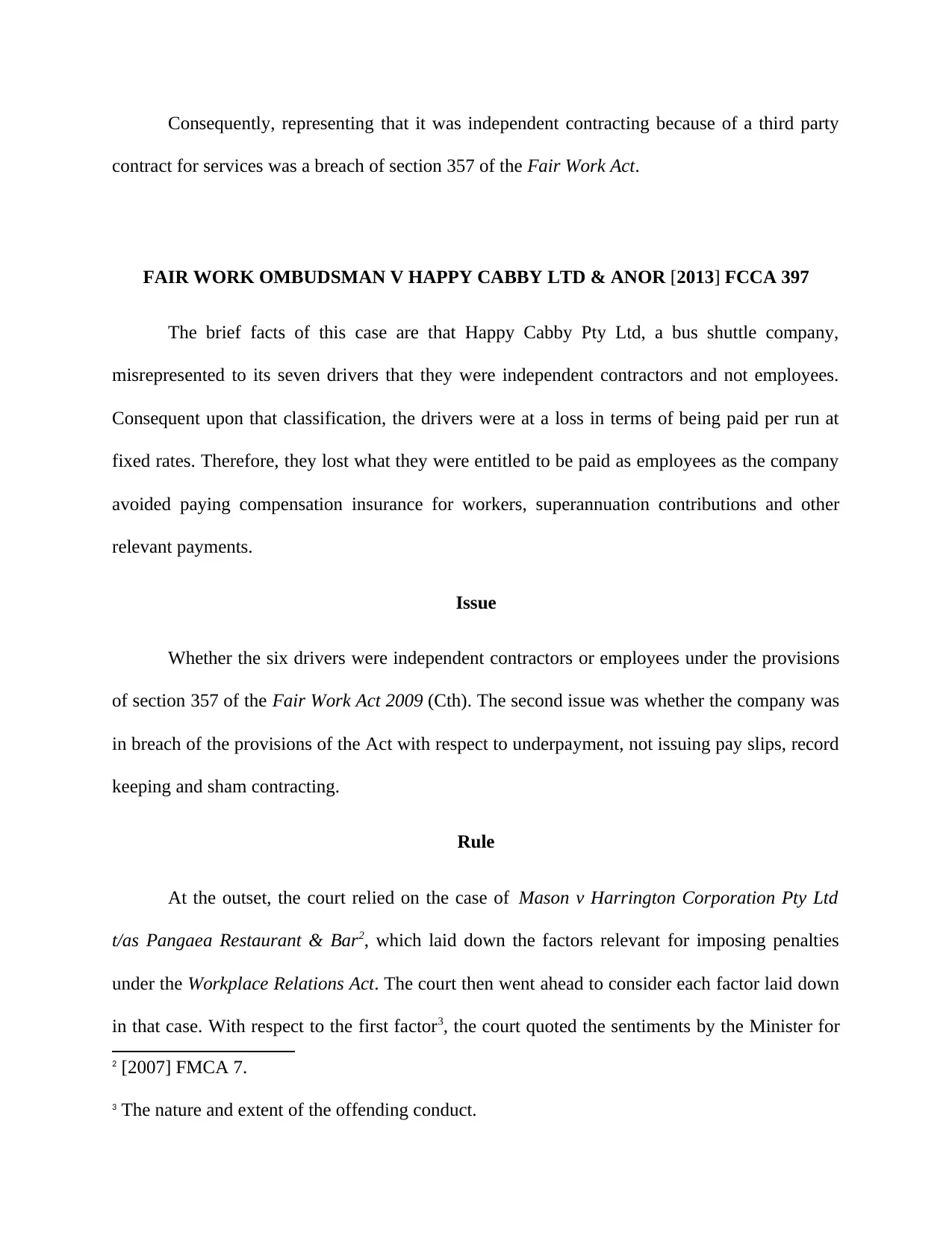
Consequently, representing that it was independent contracting because of a third party
contract for services was a breach of section 357 of the Fair Work Act.
FAIR WORK OMBUDSMAN V HAPPY CABBY LTD & ANOR [2013] FCCA 397
The brief facts of this case are that Happy Cabby Pty Ltd, a bus shuttle company,
misrepresented to its seven drivers that they were independent contractors and not employees.
Consequent upon that classification, the drivers were at a loss in terms of being paid per run at
fixed rates. Therefore, they lost what they were entitled to be paid as employees as the company
avoided paying compensation insurance for workers, superannuation contributions and other
relevant payments.
Issue
Whether the six drivers were independent contractors or employees under the provisions
of section 357 of the Fair Work Act 2009 (Cth). The second issue was whether the company was
in breach of the provisions of the Act with respect to underpayment, not issuing pay slips, record
keeping and sham contracting.
Rule
At the outset, the court relied on the case of Mason v Harrington Corporation Pty Ltd
t/as Pangaea Restaurant & Bar2, which laid down the factors relevant for imposing penalties
under the Workplace Relations Act. The court then went ahead to consider each factor laid down
in that case. With respect to the first factor3, the court quoted the sentiments by the Minister for
2 [2007] FMCA 7.
3 The nature and extent of the offending conduct.
contract for services was a breach of section 357 of the Fair Work Act.
FAIR WORK OMBUDSMAN V HAPPY CABBY LTD & ANOR [2013] FCCA 397
The brief facts of this case are that Happy Cabby Pty Ltd, a bus shuttle company,
misrepresented to its seven drivers that they were independent contractors and not employees.
Consequent upon that classification, the drivers were at a loss in terms of being paid per run at
fixed rates. Therefore, they lost what they were entitled to be paid as employees as the company
avoided paying compensation insurance for workers, superannuation contributions and other
relevant payments.
Issue
Whether the six drivers were independent contractors or employees under the provisions
of section 357 of the Fair Work Act 2009 (Cth). The second issue was whether the company was
in breach of the provisions of the Act with respect to underpayment, not issuing pay slips, record
keeping and sham contracting.
Rule
At the outset, the court relied on the case of Mason v Harrington Corporation Pty Ltd
t/as Pangaea Restaurant & Bar2, which laid down the factors relevant for imposing penalties
under the Workplace Relations Act. The court then went ahead to consider each factor laid down
in that case. With respect to the first factor3, the court quoted the sentiments by the Minister for
2 [2007] FMCA 7.
3 The nature and extent of the offending conduct.
Paraphrase This Document
Need a fresh take? Get an instant paraphrase of this document with our AI Paraphraser
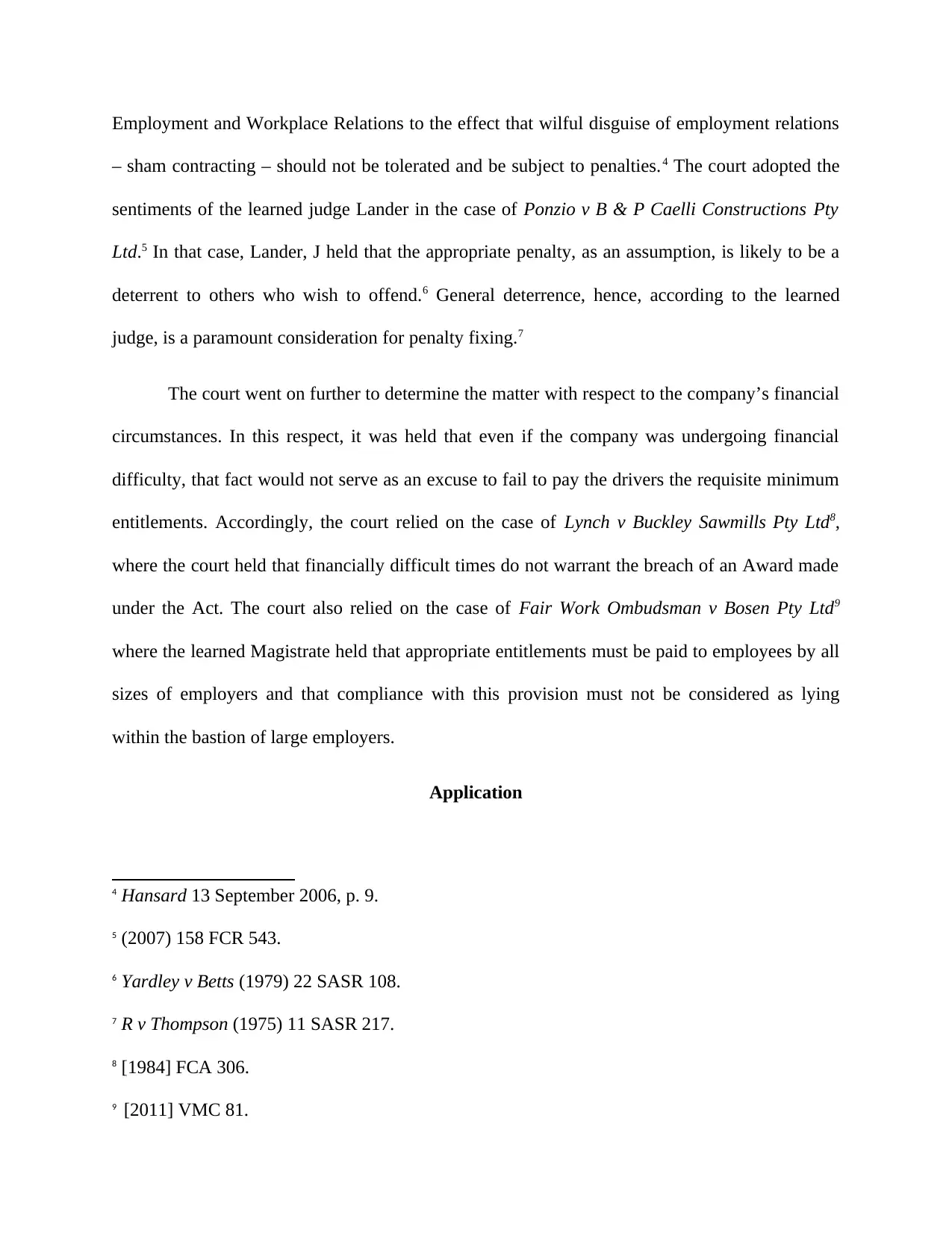
Employment and Workplace Relations to the effect that wilful disguise of employment relations
– sham contracting – should not be tolerated and be subject to penalties.4 The court adopted the
sentiments of the learned judge Lander in the case of Ponzio v B & P Caelli Constructions Pty
Ltd.5 In that case, Lander, J held that the appropriate penalty, as an assumption, is likely to be a
deterrent to others who wish to offend.6 General deterrence, hence, according to the learned
judge, is a paramount consideration for penalty fixing.7
The court went on further to determine the matter with respect to the company’s financial
circumstances. In this respect, it was held that even if the company was undergoing financial
difficulty, that fact would not serve as an excuse to fail to pay the drivers the requisite minimum
entitlements. Accordingly, the court relied on the case of Lynch v Buckley Sawmills Pty Ltd8,
where the court held that financially difficult times do not warrant the breach of an Award made
under the Act. The court also relied on the case of Fair Work Ombudsman v Bosen Pty Ltd9
where the learned Magistrate held that appropriate entitlements must be paid to employees by all
sizes of employers and that compliance with this provision must not be considered as lying
within the bastion of large employers.
Application
4 Hansard 13 September 2006, p. 9.
5 (2007) 158 FCR 543.
6 Yardley v Betts (1979) 22 SASR 108.
7 R v Thompson (1975) 11 SASR 217.
8 [1984] FCA 306.
9 [2011] VMC 81.
– sham contracting – should not be tolerated and be subject to penalties.4 The court adopted the
sentiments of the learned judge Lander in the case of Ponzio v B & P Caelli Constructions Pty
Ltd.5 In that case, Lander, J held that the appropriate penalty, as an assumption, is likely to be a
deterrent to others who wish to offend.6 General deterrence, hence, according to the learned
judge, is a paramount consideration for penalty fixing.7
The court went on further to determine the matter with respect to the company’s financial
circumstances. In this respect, it was held that even if the company was undergoing financial
difficulty, that fact would not serve as an excuse to fail to pay the drivers the requisite minimum
entitlements. Accordingly, the court relied on the case of Lynch v Buckley Sawmills Pty Ltd8,
where the court held that financially difficult times do not warrant the breach of an Award made
under the Act. The court also relied on the case of Fair Work Ombudsman v Bosen Pty Ltd9
where the learned Magistrate held that appropriate entitlements must be paid to employees by all
sizes of employers and that compliance with this provision must not be considered as lying
within the bastion of large employers.
Application
4 Hansard 13 September 2006, p. 9.
5 (2007) 158 FCR 543.
6 Yardley v Betts (1979) 22 SASR 108.
7 R v Thompson (1975) 11 SASR 217.
8 [1984] FCA 306.
9 [2011] VMC 81.
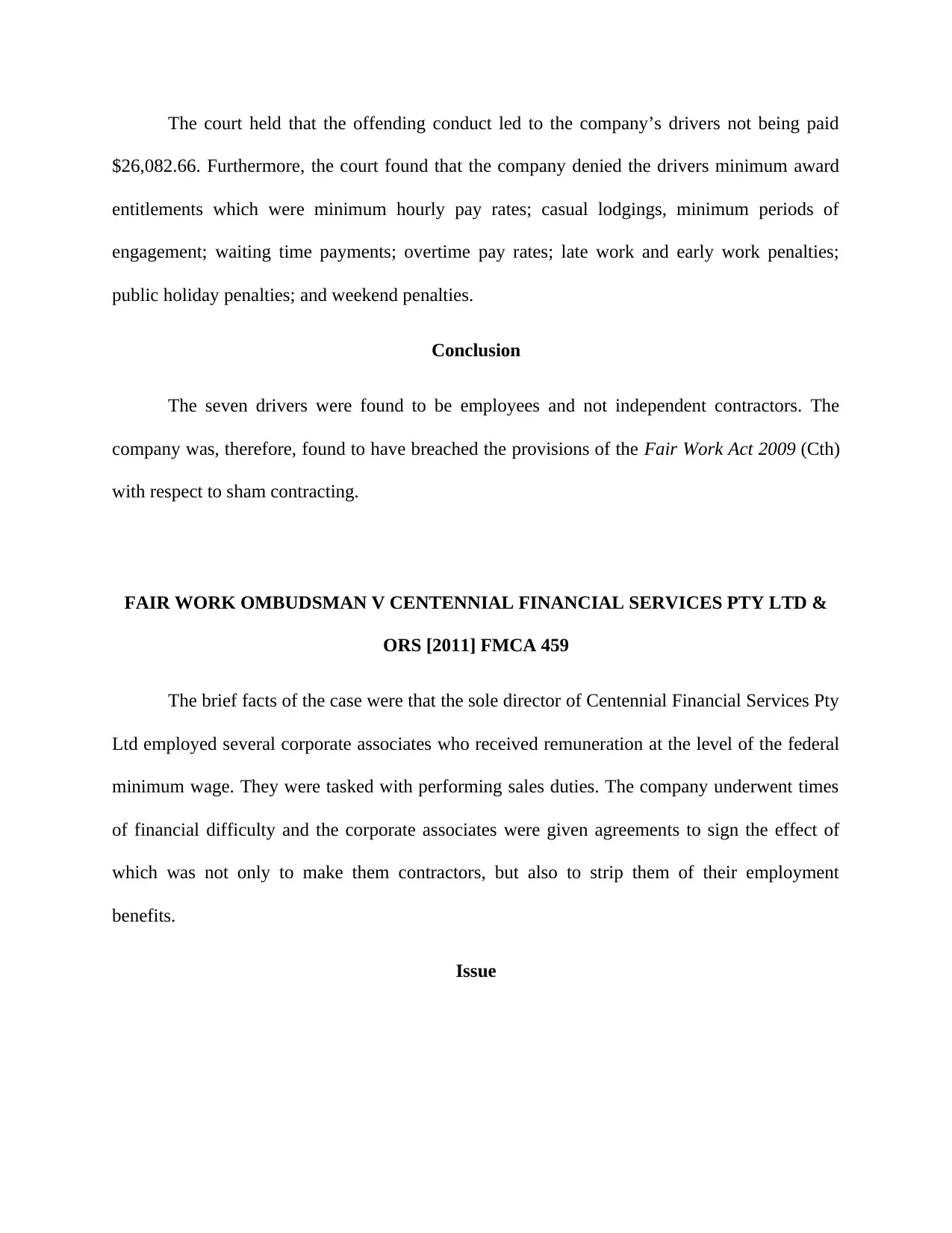
The court held that the offending conduct led to the company’s drivers not being paid
$26,082.66. Furthermore, the court found that the company denied the drivers minimum award
entitlements which were minimum hourly pay rates; casual lodgings, minimum periods of
engagement; waiting time payments; overtime pay rates; late work and early work penalties;
public holiday penalties; and weekend penalties.
Conclusion
The seven drivers were found to be employees and not independent contractors. The
company was, therefore, found to have breached the provisions of the Fair Work Act 2009 (Cth)
with respect to sham contracting.
FAIR WORK OMBUDSMAN V CENTENNIAL FINANCIAL SERVICES PTY LTD &
ORS [2011] FMCA 459
The brief facts of the case were that the sole director of Centennial Financial Services Pty
Ltd employed several corporate associates who received remuneration at the level of the federal
minimum wage. They were tasked with performing sales duties. The company underwent times
of financial difficulty and the corporate associates were given agreements to sign the effect of
which was not only to make them contractors, but also to strip them of their employment
benefits.
Issue
$26,082.66. Furthermore, the court found that the company denied the drivers minimum award
entitlements which were minimum hourly pay rates; casual lodgings, minimum periods of
engagement; waiting time payments; overtime pay rates; late work and early work penalties;
public holiday penalties; and weekend penalties.
Conclusion
The seven drivers were found to be employees and not independent contractors. The
company was, therefore, found to have breached the provisions of the Fair Work Act 2009 (Cth)
with respect to sham contracting.
FAIR WORK OMBUDSMAN V CENTENNIAL FINANCIAL SERVICES PTY LTD &
ORS [2011] FMCA 459
The brief facts of the case were that the sole director of Centennial Financial Services Pty
Ltd employed several corporate associates who received remuneration at the level of the federal
minimum wage. They were tasked with performing sales duties. The company underwent times
of financial difficulty and the corporate associates were given agreements to sign the effect of
which was not only to make them contractors, but also to strip them of their employment
benefits.
Issue
⊘ This is a preview!⊘
Do you want full access?
Subscribe today to unlock all pages.

Trusted by 1+ million students worldwide
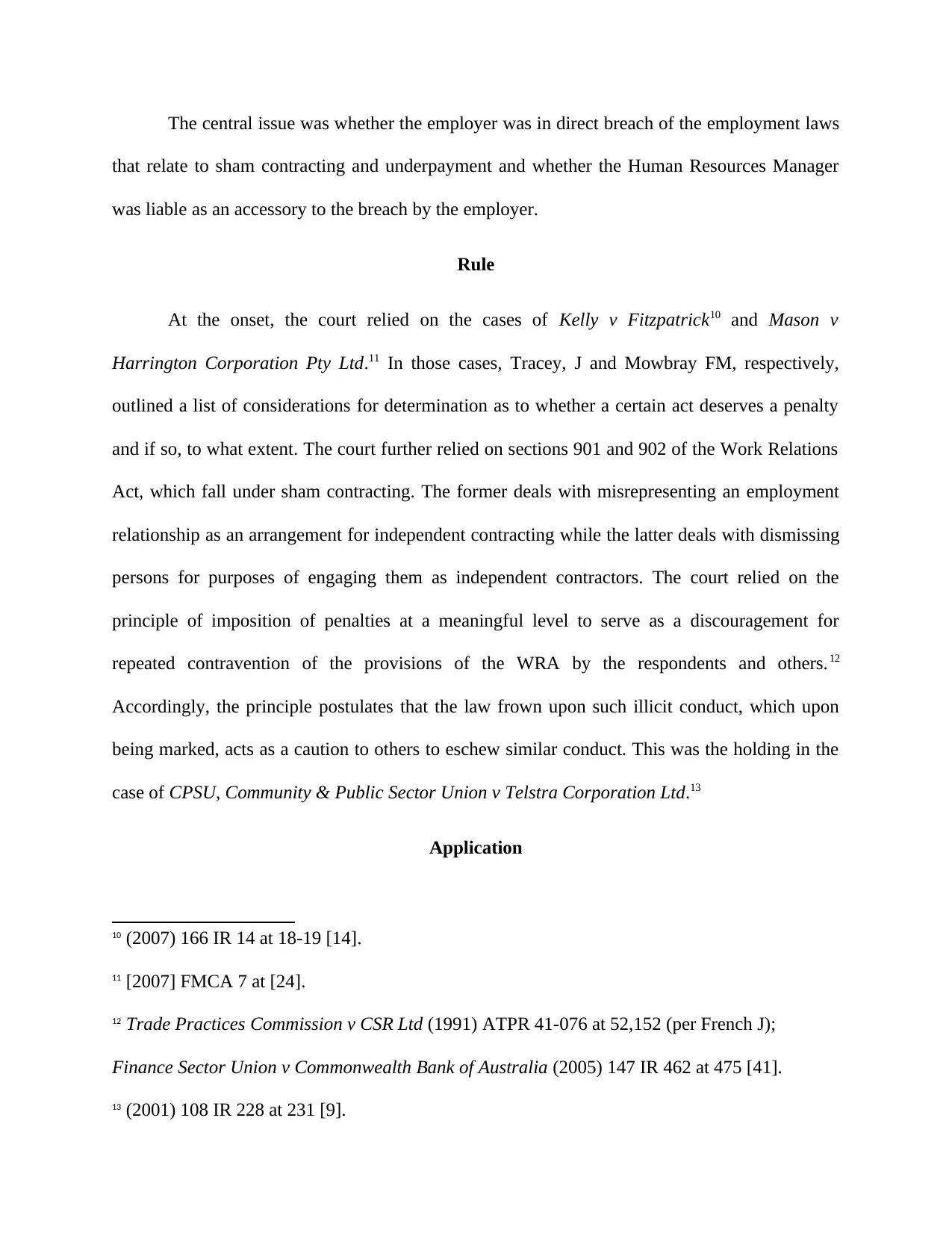
The central issue was whether the employer was in direct breach of the employment laws
that relate to sham contracting and underpayment and whether the Human Resources Manager
was liable as an accessory to the breach by the employer.
Rule
At the onset, the court relied on the cases of Kelly v Fitzpatrick10 and Mason v
Harrington Corporation Pty Ltd.11 In those cases, Tracey, J and Mowbray FM, respectively,
outlined a list of considerations for determination as to whether a certain act deserves a penalty
and if so, to what extent. The court further relied on sections 901 and 902 of the Work Relations
Act, which fall under sham contracting. The former deals with misrepresenting an employment
relationship as an arrangement for independent contracting while the latter deals with dismissing
persons for purposes of engaging them as independent contractors. The court relied on the
principle of imposition of penalties at a meaningful level to serve as a discouragement for
repeated contravention of the provisions of the WRA by the respondents and others.12
Accordingly, the principle postulates that the law frown upon such illicit conduct, which upon
being marked, acts as a caution to others to eschew similar conduct. This was the holding in the
case of CPSU, Community & Public Sector Union v Telstra Corporation Ltd.13
Application
10 (2007) 166 IR 14 at 18-19 [14].
11 [2007] FMCA 7 at [24].
12 Trade Practices Commission v CSR Ltd (1991) ATPR 41-076 at 52,152 (per French J);
Finance Sector Union v Commonwealth Bank of Australia (2005) 147 IR 462 at 475 [41].
13 (2001) 108 IR 228 at 231 [9].
that relate to sham contracting and underpayment and whether the Human Resources Manager
was liable as an accessory to the breach by the employer.
Rule
At the onset, the court relied on the cases of Kelly v Fitzpatrick10 and Mason v
Harrington Corporation Pty Ltd.11 In those cases, Tracey, J and Mowbray FM, respectively,
outlined a list of considerations for determination as to whether a certain act deserves a penalty
and if so, to what extent. The court further relied on sections 901 and 902 of the Work Relations
Act, which fall under sham contracting. The former deals with misrepresenting an employment
relationship as an arrangement for independent contracting while the latter deals with dismissing
persons for purposes of engaging them as independent contractors. The court relied on the
principle of imposition of penalties at a meaningful level to serve as a discouragement for
repeated contravention of the provisions of the WRA by the respondents and others.12
Accordingly, the principle postulates that the law frown upon such illicit conduct, which upon
being marked, acts as a caution to others to eschew similar conduct. This was the holding in the
case of CPSU, Community & Public Sector Union v Telstra Corporation Ltd.13
Application
10 (2007) 166 IR 14 at 18-19 [14].
11 [2007] FMCA 7 at [24].
12 Trade Practices Commission v CSR Ltd (1991) ATPR 41-076 at 52,152 (per French J);
Finance Sector Union v Commonwealth Bank of Australia (2005) 147 IR 462 at 475 [41].
13 (2001) 108 IR 228 at 231 [9].
Paraphrase This Document
Need a fresh take? Get an instant paraphrase of this document with our AI Paraphraser
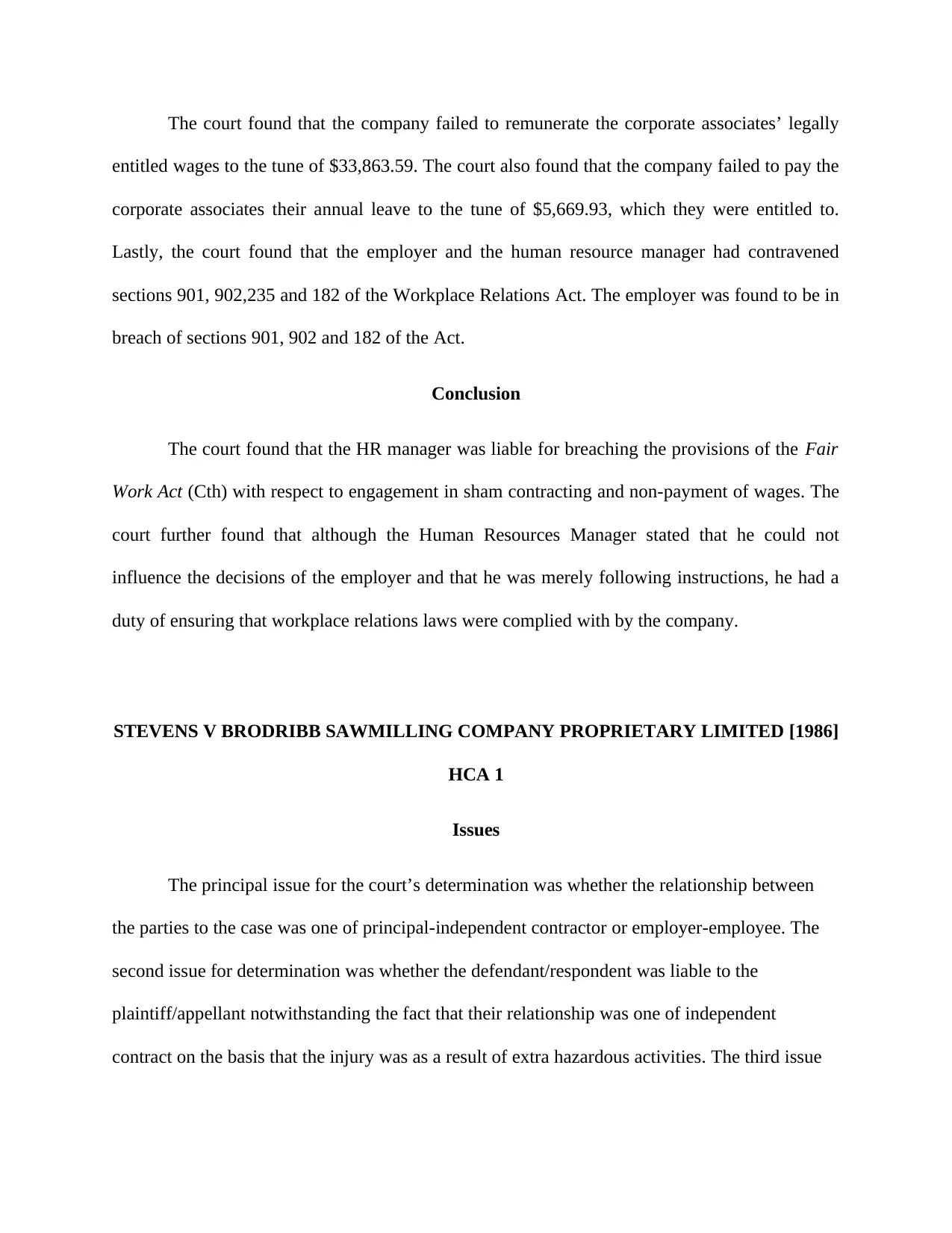
The court found that the company failed to remunerate the corporate associates’ legally
entitled wages to the tune of $33,863.59. The court also found that the company failed to pay the
corporate associates their annual leave to the tune of $5,669.93, which they were entitled to.
Lastly, the court found that the employer and the human resource manager had contravened
sections 901, 902,235 and 182 of the Workplace Relations Act. The employer was found to be in
breach of sections 901, 902 and 182 of the Act.
Conclusion
The court found that the HR manager was liable for breaching the provisions of the Fair
Work Act (Cth) with respect to engagement in sham contracting and non-payment of wages. The
court further found that although the Human Resources Manager stated that he could not
influence the decisions of the employer and that he was merely following instructions, he had a
duty of ensuring that workplace relations laws were complied with by the company.
STEVENS V BRODRIBB SAWMILLING COMPANY PROPRIETARY LIMITED [1986]
HCA 1
Issues
The principal issue for the court’s determination was whether the relationship between
the parties to the case was one of principal-independent contractor or employer-employee. The
second issue for determination was whether the defendant/respondent was liable to the
plaintiff/appellant notwithstanding the fact that their relationship was one of independent
contract on the basis that the injury was as a result of extra hazardous activities. The third issue
entitled wages to the tune of $33,863.59. The court also found that the company failed to pay the
corporate associates their annual leave to the tune of $5,669.93, which they were entitled to.
Lastly, the court found that the employer and the human resource manager had contravened
sections 901, 902,235 and 182 of the Workplace Relations Act. The employer was found to be in
breach of sections 901, 902 and 182 of the Act.
Conclusion
The court found that the HR manager was liable for breaching the provisions of the Fair
Work Act (Cth) with respect to engagement in sham contracting and non-payment of wages. The
court further found that although the Human Resources Manager stated that he could not
influence the decisions of the employer and that he was merely following instructions, he had a
duty of ensuring that workplace relations laws were complied with by the company.
STEVENS V BRODRIBB SAWMILLING COMPANY PROPRIETARY LIMITED [1986]
HCA 1
Issues
The principal issue for the court’s determination was whether the relationship between
the parties to the case was one of principal-independent contractor or employer-employee. The
second issue for determination was whether the defendant/respondent was liable to the
plaintiff/appellant notwithstanding the fact that their relationship was one of independent
contract on the basis that the injury was as a result of extra hazardous activities. The third issue
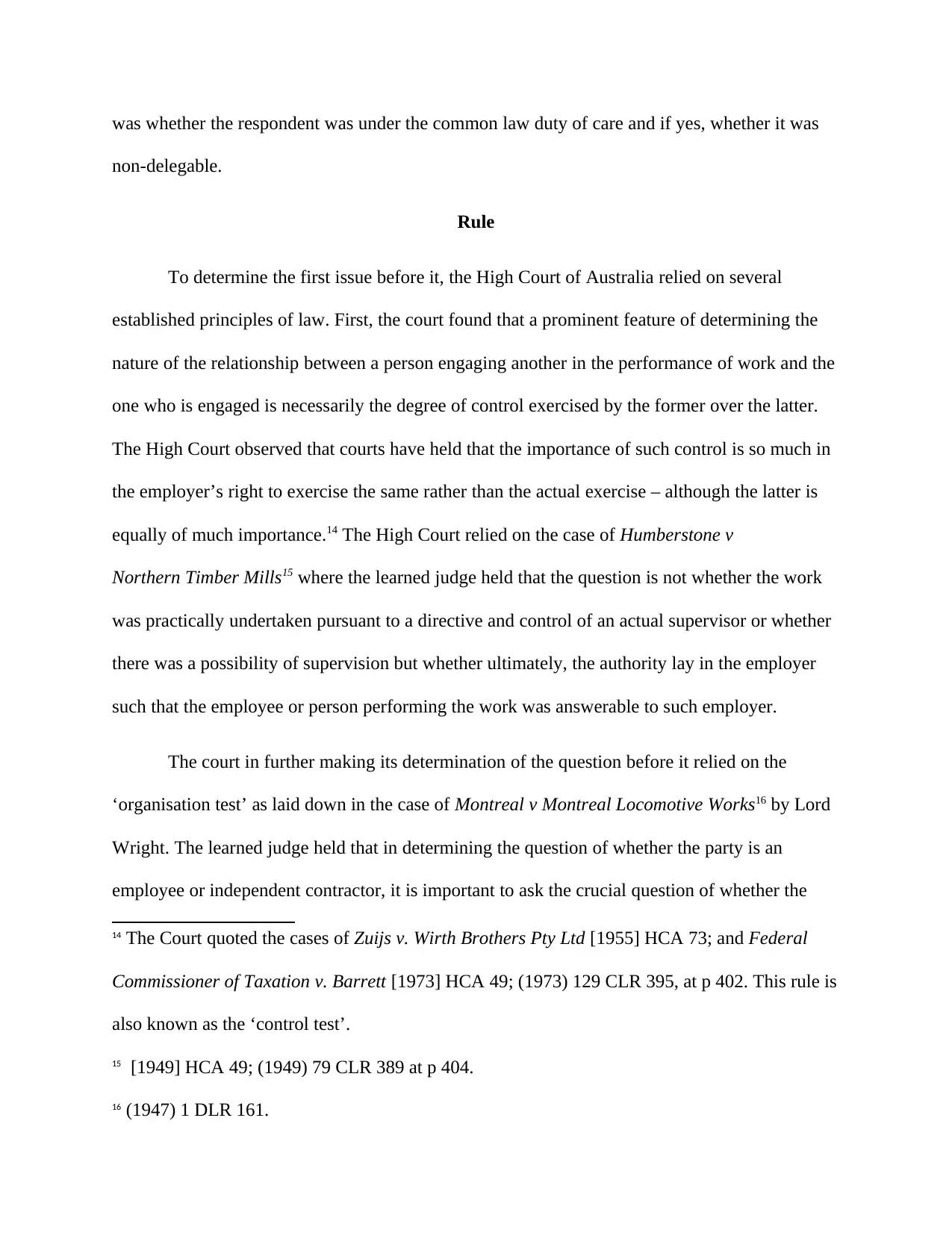
was whether the respondent was under the common law duty of care and if yes, whether it was
non-delegable.
Rule
To determine the first issue before it, the High Court of Australia relied on several
established principles of law. First, the court found that a prominent feature of determining the
nature of the relationship between a person engaging another in the performance of work and the
one who is engaged is necessarily the degree of control exercised by the former over the latter.
The High Court observed that courts have held that the importance of such control is so much in
the employer’s right to exercise the same rather than the actual exercise – although the latter is
equally of much importance.14 The High Court relied on the case of Humberstone v
Northern Timber Mills15 where the learned judge held that the question is not whether the work
was practically undertaken pursuant to a directive and control of an actual supervisor or whether
there was a possibility of supervision but whether ultimately, the authority lay in the employer
such that the employee or person performing the work was answerable to such employer.
The court in further making its determination of the question before it relied on the
‘organisation test’ as laid down in the case of Montreal v Montreal Locomotive Works16 by Lord
Wright. The learned judge held that in determining the question of whether the party is an
employee or independent contractor, it is important to ask the crucial question of whether the
14 The Court quoted the cases of Zuijs v. Wirth Brothers Pty Ltd [1955] HCA 73; and Federal
Commissioner of Taxation v. Barrett [1973] HCA 49; (1973) 129 CLR 395, at p 402. This rule is
also known as the ‘control test’.
15 [1949] HCA 49; (1949) 79 CLR 389 at p 404.
16 (1947) 1 DLR 161.
non-delegable.
Rule
To determine the first issue before it, the High Court of Australia relied on several
established principles of law. First, the court found that a prominent feature of determining the
nature of the relationship between a person engaging another in the performance of work and the
one who is engaged is necessarily the degree of control exercised by the former over the latter.
The High Court observed that courts have held that the importance of such control is so much in
the employer’s right to exercise the same rather than the actual exercise – although the latter is
equally of much importance.14 The High Court relied on the case of Humberstone v
Northern Timber Mills15 where the learned judge held that the question is not whether the work
was practically undertaken pursuant to a directive and control of an actual supervisor or whether
there was a possibility of supervision but whether ultimately, the authority lay in the employer
such that the employee or person performing the work was answerable to such employer.
The court in further making its determination of the question before it relied on the
‘organisation test’ as laid down in the case of Montreal v Montreal Locomotive Works16 by Lord
Wright. The learned judge held that in determining the question of whether the party is an
employee or independent contractor, it is important to ask the crucial question of whether the
14 The Court quoted the cases of Zuijs v. Wirth Brothers Pty Ltd [1955] HCA 73; and Federal
Commissioner of Taxation v. Barrett [1973] HCA 49; (1973) 129 CLR 395, at p 402. This rule is
also known as the ‘control test’.
15 [1949] HCA 49; (1949) 79 CLR 389 at p 404.
16 (1947) 1 DLR 161.
⊘ This is a preview!⊘
Do you want full access?
Subscribe today to unlock all pages.

Trusted by 1+ million students worldwide
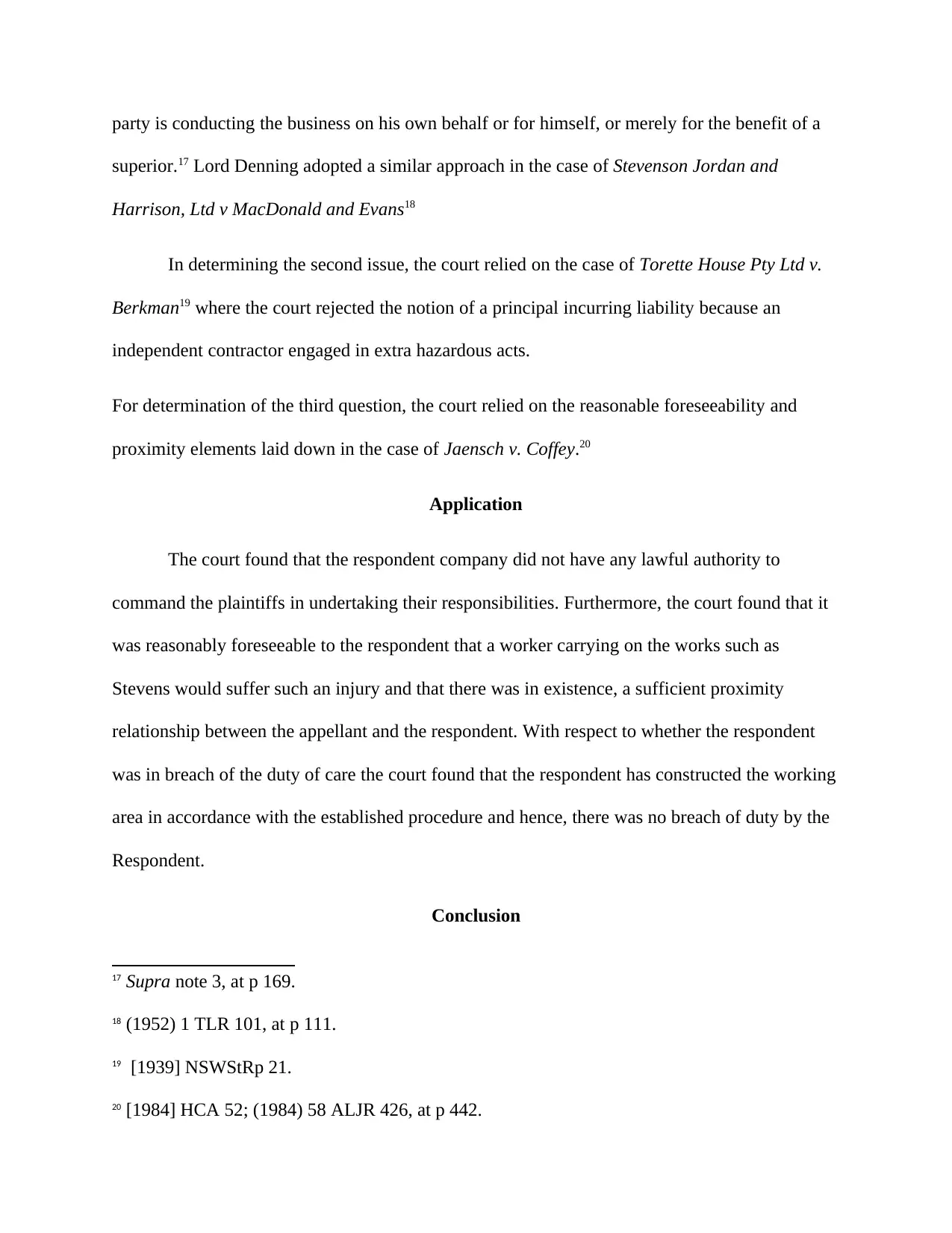
party is conducting the business on his own behalf or for himself, or merely for the benefit of a
superior.17 Lord Denning adopted a similar approach in the case of Stevenson Jordan and
Harrison, Ltd v MacDonald and Evans18
In determining the second issue, the court relied on the case of Torette House Pty Ltd v.
Berkman19 where the court rejected the notion of a principal incurring liability because an
independent contractor engaged in extra hazardous acts.
For determination of the third question, the court relied on the reasonable foreseeability and
proximity elements laid down in the case of Jaensch v. Coffey.20
Application
The court found that the respondent company did not have any lawful authority to
command the plaintiffs in undertaking their responsibilities. Furthermore, the court found that it
was reasonably foreseeable to the respondent that a worker carrying on the works such as
Stevens would suffer such an injury and that there was in existence, a sufficient proximity
relationship between the appellant and the respondent. With respect to whether the respondent
was in breach of the duty of care the court found that the respondent has constructed the working
area in accordance with the established procedure and hence, there was no breach of duty by the
Respondent.
Conclusion
17 Supra note 3, at p 169.
18 (1952) 1 TLR 101, at p 111.
19 [1939] NSWStRp 21.
20 [1984] HCA 52; (1984) 58 ALJR 426, at p 442.
superior.17 Lord Denning adopted a similar approach in the case of Stevenson Jordan and
Harrison, Ltd v MacDonald and Evans18
In determining the second issue, the court relied on the case of Torette House Pty Ltd v.
Berkman19 where the court rejected the notion of a principal incurring liability because an
independent contractor engaged in extra hazardous acts.
For determination of the third question, the court relied on the reasonable foreseeability and
proximity elements laid down in the case of Jaensch v. Coffey.20
Application
The court found that the respondent company did not have any lawful authority to
command the plaintiffs in undertaking their responsibilities. Furthermore, the court found that it
was reasonably foreseeable to the respondent that a worker carrying on the works such as
Stevens would suffer such an injury and that there was in existence, a sufficient proximity
relationship between the appellant and the respondent. With respect to whether the respondent
was in breach of the duty of care the court found that the respondent has constructed the working
area in accordance with the established procedure and hence, there was no breach of duty by the
Respondent.
Conclusion
17 Supra note 3, at p 169.
18 (1952) 1 TLR 101, at p 111.
19 [1939] NSWStRp 21.
20 [1984] HCA 52; (1984) 58 ALJR 426, at p 442.
Paraphrase This Document
Need a fresh take? Get an instant paraphrase of this document with our AI Paraphraser
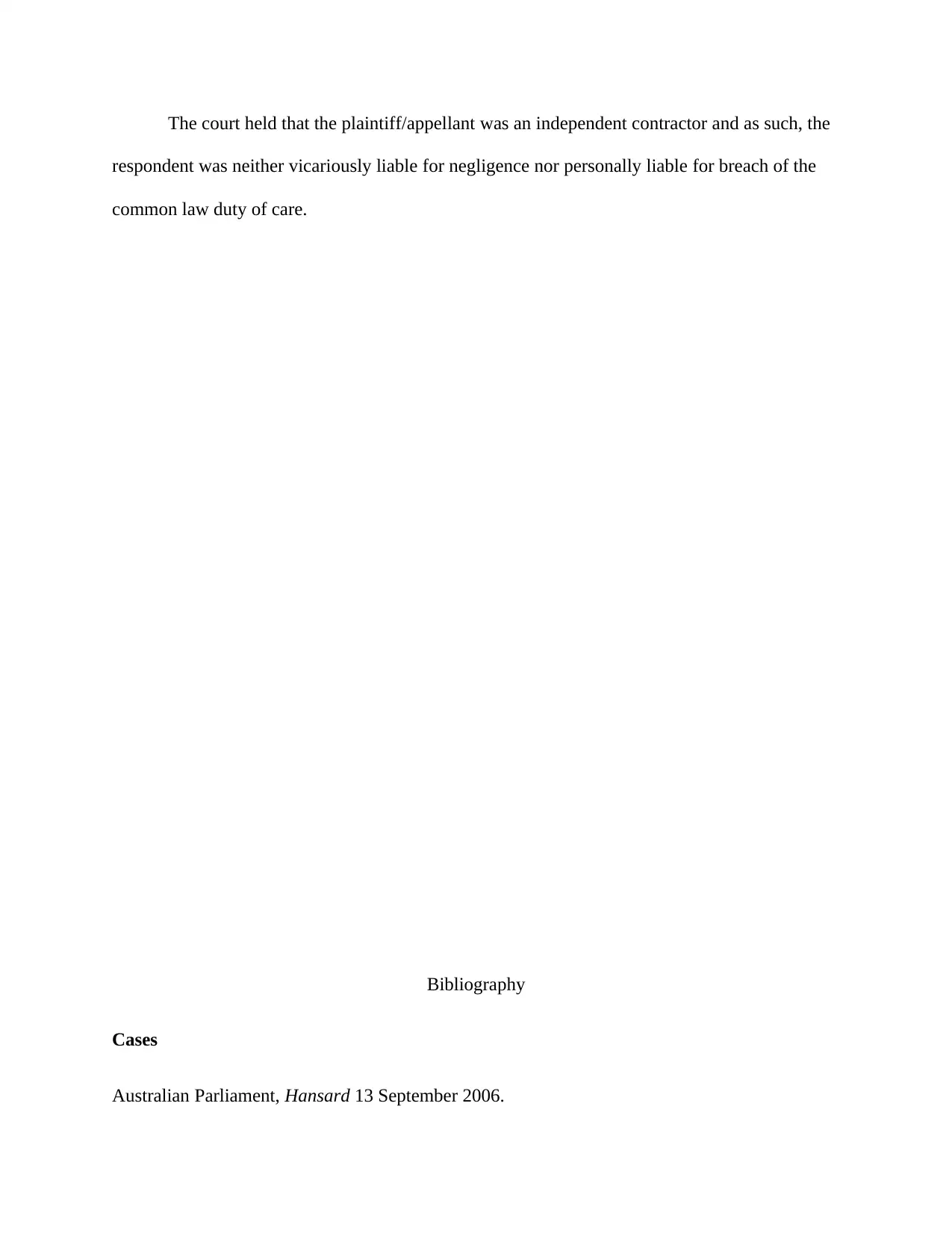
The court held that the plaintiff/appellant was an independent contractor and as such, the
respondent was neither vicariously liable for negligence nor personally liable for breach of the
common law duty of care.
Bibliography
Cases
Australian Parliament, Hansard 13 September 2006.
respondent was neither vicariously liable for negligence nor personally liable for breach of the
common law duty of care.
Bibliography
Cases
Australian Parliament, Hansard 13 September 2006.
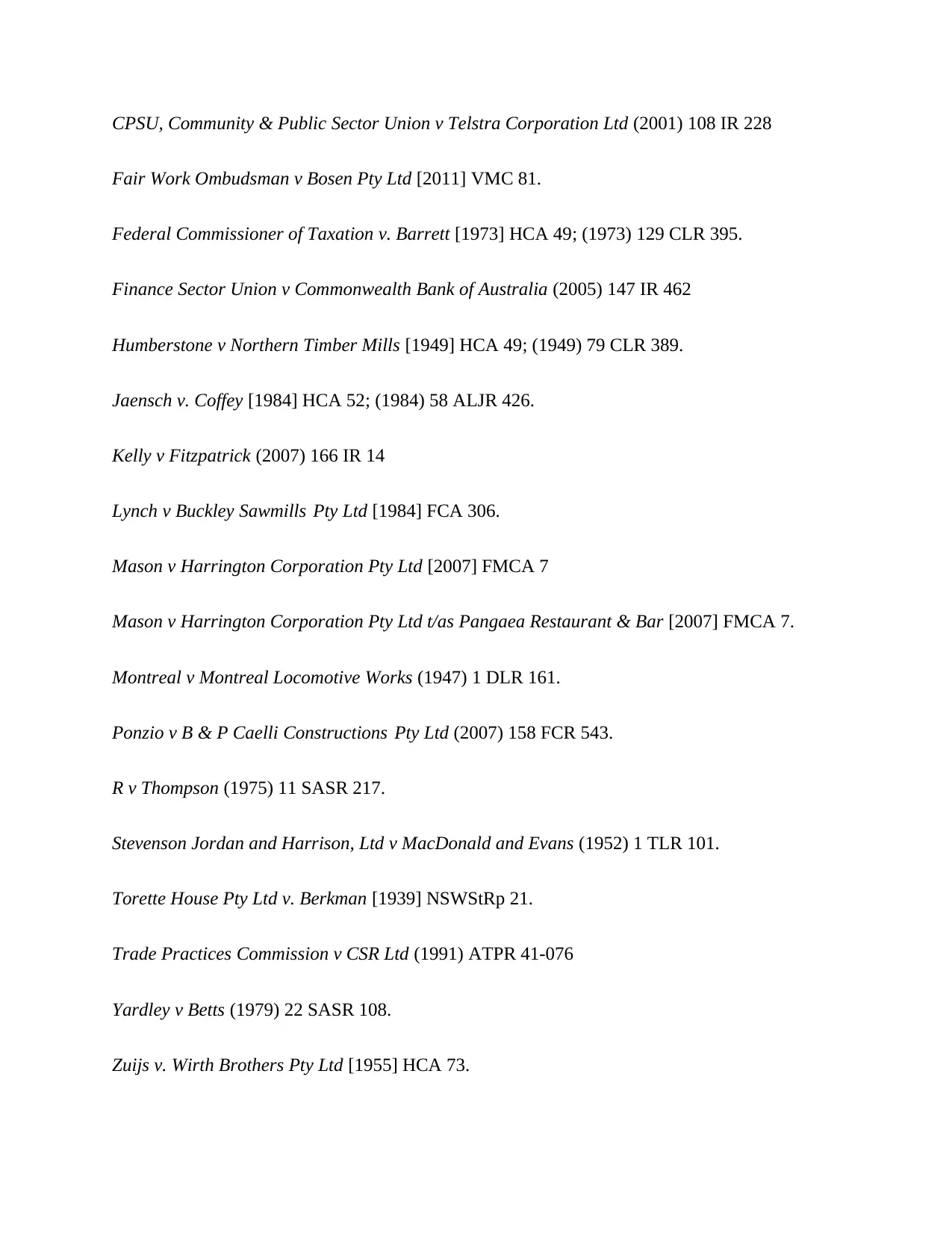
CPSU, Community & Public Sector Union v Telstra Corporation Ltd (2001) 108 IR 228
Fair Work Ombudsman v Bosen Pty Ltd [2011] VMC 81.
Federal Commissioner of Taxation v. Barrett [1973] HCA 49; (1973) 129 CLR 395.
Finance Sector Union v Commonwealth Bank of Australia (2005) 147 IR 462
Humberstone v Northern Timber Mills [1949] HCA 49; (1949) 79 CLR 389.
Jaensch v. Coffey [1984] HCA 52; (1984) 58 ALJR 426.
Kelly v Fitzpatrick (2007) 166 IR 14
Lynch v Buckley Sawmills Pty Ltd [1984] FCA 306.
Mason v Harrington Corporation Pty Ltd [2007] FMCA 7
Mason v Harrington Corporation Pty Ltd t/as Pangaea Restaurant & Bar [2007] FMCA 7.
Montreal v Montreal Locomotive Works (1947) 1 DLR 161.
Ponzio v B & P Caelli Constructions Pty Ltd (2007) 158 FCR 543.
R v Thompson (1975) 11 SASR 217.
Stevenson Jordan and Harrison, Ltd v MacDonald and Evans (1952) 1 TLR 101.
Torette House Pty Ltd v. Berkman [1939] NSWStRp 21.
Trade Practices Commission v CSR Ltd (1991) ATPR 41-076
Yardley v Betts (1979) 22 SASR 108.
Zuijs v. Wirth Brothers Pty Ltd [1955] HCA 73.
Fair Work Ombudsman v Bosen Pty Ltd [2011] VMC 81.
Federal Commissioner of Taxation v. Barrett [1973] HCA 49; (1973) 129 CLR 395.
Finance Sector Union v Commonwealth Bank of Australia (2005) 147 IR 462
Humberstone v Northern Timber Mills [1949] HCA 49; (1949) 79 CLR 389.
Jaensch v. Coffey [1984] HCA 52; (1984) 58 ALJR 426.
Kelly v Fitzpatrick (2007) 166 IR 14
Lynch v Buckley Sawmills Pty Ltd [1984] FCA 306.
Mason v Harrington Corporation Pty Ltd [2007] FMCA 7
Mason v Harrington Corporation Pty Ltd t/as Pangaea Restaurant & Bar [2007] FMCA 7.
Montreal v Montreal Locomotive Works (1947) 1 DLR 161.
Ponzio v B & P Caelli Constructions Pty Ltd (2007) 158 FCR 543.
R v Thompson (1975) 11 SASR 217.
Stevenson Jordan and Harrison, Ltd v MacDonald and Evans (1952) 1 TLR 101.
Torette House Pty Ltd v. Berkman [1939] NSWStRp 21.
Trade Practices Commission v CSR Ltd (1991) ATPR 41-076
Yardley v Betts (1979) 22 SASR 108.
Zuijs v. Wirth Brothers Pty Ltd [1955] HCA 73.
⊘ This is a preview!⊘
Do you want full access?
Subscribe today to unlock all pages.

Trusted by 1+ million students worldwide
1 out of 14
Related Documents
Your All-in-One AI-Powered Toolkit for Academic Success.
+13062052269
info@desklib.com
Available 24*7 on WhatsApp / Email
![[object Object]](/_next/static/media/star-bottom.7253800d.svg)
Unlock your academic potential
Copyright © 2020–2025 A2Z Services. All Rights Reserved. Developed and managed by ZUCOL.





